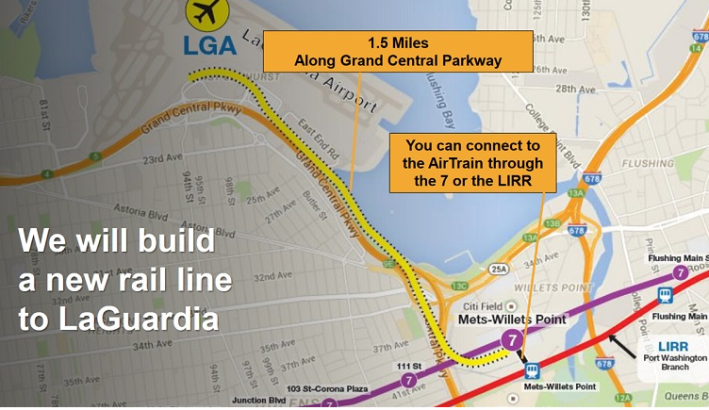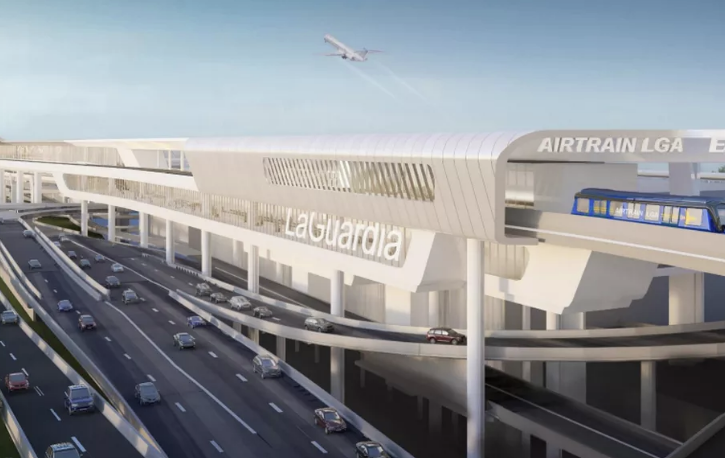The Federal Aviation Authority is holding workshops and public hearings starting on Tuesday about the Port Authority of New York and New Jersey's plan to build a rail link between LaGuardia Airport and the 7 train and Long Island Rail Road stations at Willets Point, about two miles to the east of the airfield. The proposal is controversial because of its route, its cost, its usefulness and its very place in a post-COVID world. Streetsblog has consistently covered the issue (archive here), but today we present multiple op-eds from various players. For more information about the virtual workshops and public hearing, click here.
The proposed $2-billion AirTrain to LaGuardia Airport never made fiscal, environmental, or transit sense when New York and the project's sponsor, the Port Authority of New York and New Jersey, had the funds to build it — which is why it long ago gained the reputation as a boondoggle whose scant benefits did not justify it ballooning costs.
Now, with COVID-19's huge hit to the Port Authority's revenues, the agency is flat-out broke, and the AirTrain (along with the rest of the Port Authority's $20 billion capital program) is on life support. Gov. Cuomo has resorted to begging the Trump administration and Congress for the funds to build it — even as, for years, Cuomo promoted the AirTrain as a cost-free proposal for taxpayers, arguing that passenger facilities charges would pay for it. Thus, on purely fiscal grounds, the AirTrain represents the height of irresponsibility.
But, even more so, many assumptions about ridership and air travel that underlay the initial push for the project have changed vastly because of COVID. The new reality means that the draft environmental impact statement, which the Federal Aviation Administration published last month, is simply outdated: The evidence it is weighing is no longer material or relevant. Conclusions based on such evidence cannot be valid.
Today the FAA is holding its first virtual public hearing on the draft EIS, whose public comment period ends Oct. 5. It’s time for the public to demand that the Port Authority pull the plug, take a deep breath, and come up with a plan that not only makes fiscal sense, but — unlike the AirTrain — works as a logical complement to the city’s subway infrastructure.
The AirTrain is a proposed elevated people-mover that would run 1.5 miles from LaGuardia Airport in East Elmhurst, Queens, alongside the Grand Central Parkway and then along the Flushing Bay promenade to Willets Point, where it would connect to the 7 subway line and the Long Island Rail Road’s Port Washington branch. Transit experts always hated the project, which fails to connect with transit hubs, rests on dubious assumptions about the connecting trains, and adds nothing to the larger transit system.
At the project's inception, in 2015, the sponsors assumed that growing air travel would generate a certain number of passengers that would logistically and financially support the project. The Port Authority justified the need for an AirTrain based on projections of millions more air travelers using LGA, for an estimated 6.6 million annual AirTrain trips, according to its 2018 ridership report.

Yet COVID-19 reduced air travel by about 90 percent in the early months of the pandemic; it has yet to recover. In the last week, it was reported that at least 11,000 travelers had been exposed to the disease on airplanes, and the Centers for Disease Control and Prevention gave conflicting advice about whether airborne virus particles linger in enclosed spaces, such as planes. With all the uncertainty about air travel's prospects as the pandemic fails to subside, it is highly questionable whether the Port Authority's years-old projections remain material and relevant to a determination of the need for an AirTrain.
Further, the pandemic also has undermined Port Authority's assumptions about the AirTrain's integration with the city's transit system. The agency had assumed that ridership would transfer seamlessly from the AirTrain to the 7 Train at Willets Point — or would use the Port Washington trains at Penn Station to ride to Willets. But the willingness of New Yorkers, let alone traveling visitors to the city, to use the subway or the LIRR is still a major question. Here, too, ridership was also down by catastrophic percentages and remains low.
We can't know the future — and perhaps air travel will rebound robustly. But the Port Authority is operating on a wing and a prayer — and with empty coffers. New Yorkers must demand better — especially for a project that will adversely affect the environment of Flushing Bay and that will be built in their backyards.
In our view, the environmental review never belonged at a federal agency in the first place. The federal standards, unlike those locally based rules that governed the oversight of the 1995 JFK AirTrain, do not provide rigorous community participation and political oversight by the elected officials who are closest to the project. The more thorough local review that comes with the city's Uniform Land Use Review Process would likely engender a new configuration that actually makes transit sense.
What is unquestionable, however, is that the loss of expected revenues, the need for a federal bailout, and a collapse of anticipated ridership, mean that the FAA review must be jettisoned because it has lost any legitimacy it might have had before the virus hit.
Frank Taylor is the president of the Ditmars Block Association, which represents homeowners affected by the AirTrain. James Carriero is an attorney for the group and a member.






